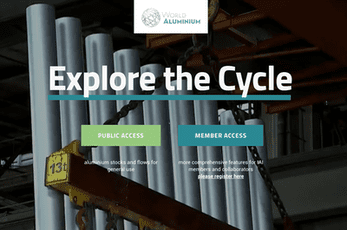There are some important regions of the world where there is limited data available on aluminium collection and recycling rates.
Because of this, data collection has been complemented by the development of a global material flow model that traces the flow of aluminium from 1888 to the present along the complete value chain within and between 9 regions and allows for building scenarios for flows out to 2040. Eight major processes are investigated: bauxite mining, alumina refining, aluminium and aluminium ingot production, fabrication (rolling, extrusion and casting), manufacturing (production and assembly of finished products), use and recycling.
Alucycle utilised the material flow model data and provides you with robust aluminium stocks and flows visualizations for use in presentations, teaching toolkits and policy documents.
Among other things the visualisation shows that:
- In 2009, 18 million tonnes of scrap were available worldwide. In 2019 this scrap availability has increased to 33 million tonnes. Growing by an average 6% YOY.
- North America, being historically the largest generator of scrap globally, was overtaken by China in 2014, which generated 6.5 million tonnes of scrap in that year.
- In 2018, 22 million tonnes aluminium contained in bauxite were traded between the nine regions, followed by aluminium contained in final products (20 million tonnes), ingots (15 million tonnes), semis (7 million tonnes) and scrap (4.5 million tonnes).
The property of recyclability means that the world’s increasing stock in use of aluminium acts like a resource bank, over time delivering more and more practical use and value from the energy embodied in the metal at the time of its production.
The amount of aluminium produced from old scrap has grown from one million tonnes in 1980 to 20 million tonnes in 2019. Since the 1980s the transport sector has been the most important resource for recycled aluminium from end-of-life products. As aluminium construction products often have lifetimes running into decades, scrap from building applications has only become available in the 2000s and only in the quantities put into such applications when the buildings were constructed, over 30 years ago.
Today recycled aluminium produced from old scrap originates 33% from transport, 26% from packaging, 13% from engineering and cables and 16% from building applications, due to their long lifetimes.
Of the estimated 1.5 billion tonnes of aluminium produced since 1880, three quarters is still in productive use. In 2019, around 36% is located in buildings, 25% in electrical cables and machinery and 30% within transport applications. Recycling the metal currently stored in use would equal up to 24 years’ worth of current annual primary aluminium production.
Housing a century’s worth of industry data, the IAI’s most comprehensive industry data set yet, is available here. Built on the aluminium industry’s data from 1962 – 2019 and demand scenarios to 2040, Alucycle presents almost two decades of Material Flow Analysis modelling. The site is interactive and enables regional analysis of the aluminium chain overtime. Members and collaborators can access the exclusive ‘Member Access’ area to access the data in various formats.
